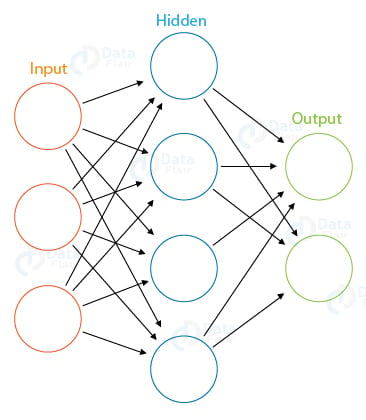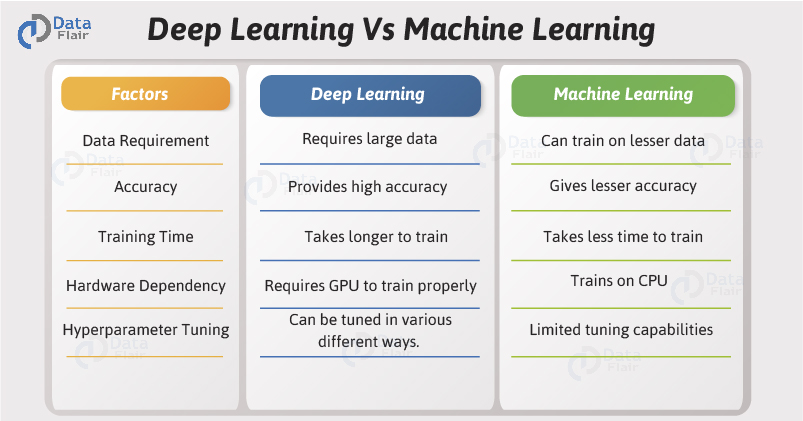Deep Learning vs Machine Learning – Demystified in Simple Words
Free Machine Learning courses with 130+ real-time projects Start Now!!
Deep Learning and Machine Learning are the two most trending technologies in the world today. These technologies are often used interchangeably. While Deep Learning is the subset of machine learning, many people get confused between these two terminologies. So, for clearing this confusion today, we came up with our new article – Deep Learning vs Machine learning. This article consists of the feature-wise difference between both. Also, we will discuss applications, future trends, and where
Introduction to Deep Learning and Machine Learning
1. What is Machine Learning?
Machine Learning is the scientific study of statistical models and algorithms that computer systems use to perform a task without explicit instructions. Machine Learning is a comprehensive field that involves various functionalities of machine learning operations like clustering, classification and development of predictive models.
Basically, Machine Learning allows computers to learn without an explicit need for programming.
In general programming scenarios, you have to provide instructions to the computer for it to provide you with the output. However, with the help of machine learning algorithms, you can train your computer to provide you with the output with the need to give instructions. A machine learning algorithm is able to do so with the help of data. Using the data fed to the system, a machine learning algorithm is trained to provide output to the users. There are three main types of machine learning algorithms –
1.1 Supervised Learning
In a supervised learning algorithm, the input data is labeled such that the data is organized. The computer is able to follow the examples of input-output pairs and train the model to fit the data with good accuracy. Some of the supervised learning algorithms are –
- Linear & Multivariate Regression
- Logistic Regression
- Naive Bayes
- Decision Trees
- K-nearest neighbour
- Linear Discriminant Analysis
- Artificial Neural Networks
1.2 Unsupervised Learning
In Unsupervised Learning, the data is not labeled or categorized. In Unsupervised learning, the data is able to organize itself after it follows a certain pattern in the way the data is distributed. Unsupervised learning algorithms are complex and are currently under research. Some of the unsupervised learning algorithms are –
- Clustering Analysis
- Anomaly Detection
- Hierarchical Clustering
- Principal Component Analysis
1.3. Reinforcement Machine Learning Algorithms
We use these algorithms to choose an action. Also, we can see that it is based on each data point. Moreover, after some time the algorithm changes its strategy to learn better. Also, achieve the best reward.
Machine Learning is used in various industries that require future prediction, identification of patterns and autonomous decision making. It is widely used in healthcare, finance, banking, manufacturing and transportation sectors.
2. What is Deep Learning?
Deep Learning is a recent field that occupies the much broader field of Machine Learning. Deep Learning is most famous for its neural networks such as Recurrent Neural Networks, Convolutional Neural Networks, and Deep Belief Networks. While other machine learning algorithms employ statistical analysis techniques for pattern recognition, Deep learning is modeled after the neurons of the human brain.
They are modeled after the structure and functioning of the human brain. In order to understand deep learning, we have to understand how the nervous system in the human body works. As we all know that our nervous system is built up of neurons. These neurons are able to grasp information that is transmitted to our body. These neurons have the ability to learn information over time. This principle of ‘learning’ is also utilized by artificial neural networks.
Any Deep neural network will consist of three types of layers:
- The Input Layer
- The Hidden Layer
- The Output Layer
 In the above example, the layers are present in the form of input layer, that takes the input data. The hidden layer, which performs various computation on the input data and the output layer, which in the above visualization is binary. It is to be noted that a neural network can have multiple hidden layers.
In the above example, the layers are present in the form of input layer, that takes the input data. The hidden layer, which performs various computation on the input data and the output layer, which in the above visualization is binary. It is to be noted that a neural network can have multiple hidden layers.
These neural networks are used to predict the output as well as perform classification on the data. The standard notion is that the neural network learns the pattern of data, then performs predictions that fall in the same line as the pre-specified pattern.
Deep Learning vs Machine Learning
We use a machine algorithm to parse data, learn from that data. And make informed decisions based on what it has learned. Basically, deep learning is used in layers to create an artificial “neural network”. That can learn and make intelligent decisions on its own.
Let’s understand the comparison of deep learning vs machine learning through their features –
1. Data dependencies
Performance is the main key difference between both algorithms. Although, when the data is small, deep learning algorithms don’t perform well. This is the only reason Deep Learning algorithms need a large amount of data to understand it perfectly.
But, we can see the use of algorithms with their handcrafted rules prevail in this scenario. Above image summarizes this fact.
2. Hardware dependencies
3. Feature engineering
It’s a general process. In this, domain knowledge is put into the creation of feature extractors. Also, to reduce the complexity of the data. Further, make patterns more visible to learn algorithm working. Although, it’s very difficult to process. Hence, it’s time consuming and expertise.
4. Problem Solving approach
Generally, we use traditional algorithm to solve problems. Although, it needs to break a problem into different parts. Further, solve them individually. Moreover, to get a result, combine them all.
For Example –
You have a task of multiple object detection. Although, in this task we have to identify what is the object and where is it present in the image. Further, in a machine learning approach, we have to divide the problem into two steps:
- Object detection
- Object recognition
First, we use grabcut algorithm to skim through the image and find all the possible objects. Then of all the recognized objects, you would then use object recognition algorithm like SVM with HOG to recognize relevant objects.
5. Execution time
6. Interpretability
We have interpretability as a factor for comparison of both learning techniques. Although, deep learning is still thought 10 times before its use in industry.
You must check the master comparison of AI vs Data Science vs ML vs Deep Learning
Where is Machine Learning and Deep Learning Being Applied?
1. Computer Vision
We use this both for different applications like vehicle number plate identification and facial recognition.
2. Information Retrieval
We use ML and DL for applications like search engines, both text search, and image search.
3. Marketing
We use this learning technique in automated email marketing, and in target identification.
4. Medical Diagnosis
It has very wide usage in the medical field also. Applications like cancer identification, anomaly detection
- For applications like sentiment analysis, photo tagging, online Advertising, etc
Applications of Deep Learning & Machine Learning
Following are some of the real-life applications of Deep Learning and Machine Learning –
- Machine Learning technologies are being widely used for medical imaging. For finding tumors and other malignant in the human body.
- In the field of Marketing, Machine Learning based time-series forecasting are being used for predicting sales.
- Deep Learning is playing a major role in the development of industrial robotics.
In the self-driving car industry, machine learning algorithms are used for navigating the vehicle to its destination. - Natural Language Processing is being used by the industries to analyze customer reviews and gain insights about their sentiments.
- E-commerce industries are using Deep Learning based recommendation systems to provide insights to the customers based on their purchasing patterns.
Future Trends
- Nowadays machine learning and data science are in trend. In companies, demand for both is rapidly increasing. Also, their demand particularly for some companies. i.e. company who wants to survive to inculcate Machine Learning in their business. Also, it’s necessary to know basic terminologies.
- Deep learning is discovered and prove the best technique with state-of-the-art performances. Thus, deep learning is surprising us and will continue to do so in the near future.
- Recently, researchers are continuous in Machine Learning and Deep Learning. In the past, researchers are limited to academia. But, nowadays, research in ML and DL is making their place in both industry and academia.
Learn more about the future of machine learning
Summary
In this article, we studied various concepts behind Deep Learning and Machine Learning. We understood how they function, their principle analogies and their usages. Also, we discussed the feature-wise comparison of deep learning vs machine learning. We hope that you are able to understand these key concepts and how they have transformed our industry.
If you have any questions about deep learning and machine learning, comment below. We will definitely get back to you.
Your opinion matters
Please write your valuable feedback about DataFlair on Google




Hmmn, even a less fortunate, information technology inert, could understand what you are talking about and i am glad that we have writers like you to simplify and present deep learning vs machine learning in a visually simple, linguistically smart and approach wise innovative way. I am glad i joined the group. Feel a little nervous but being the nerdy nerd i am I feel over confident that pretty soon i will be writing blogs on this myself! Honestly a very informative article.
Hi Robina,
We are glad you like and appreciate our content. It is feedback from loyal readers like you that keep our spirits going. We are excited to hear about your future plans; hope to see Data Flair find a place in your list of sources.
Keep Visiting Keep Learning
Regards,
Data-Flair
Fantastic article!!!! Thank you! It is very rare that I see especially within this field an article that talks about a complex topic and makes it really easy to understand and super informative!
I really appreciate this article, it is apt and clear. I had been struggling to understand the difference between Machine Learning and Deep Learning but I am happy your article made it clear. I hope to review more article on both to be able to choose the right learning when solving specific problem. If one does not understand the difference, it will be very difficult to choose the right learning model. A lot of people have been using these models ignorantly in solving different problems. I encourage you to do more to us in this area to enable some of us from the developing Countries like Nigeria to be able to understand and apply them in solving problems within our domain. Thank you once again for your time in developing this article and and sharing with us in your blog. I hope in the nearest future, I should be able to contribute in this new area of research.
Thanks for your generous response. Share the machine learning tutorial with your friends on social media & let them also know the difference between machine learning & deep learning.
Thanks for your contribution. Pleases can you please elaborate more on NLP algorithm and it’s applications . Thanks